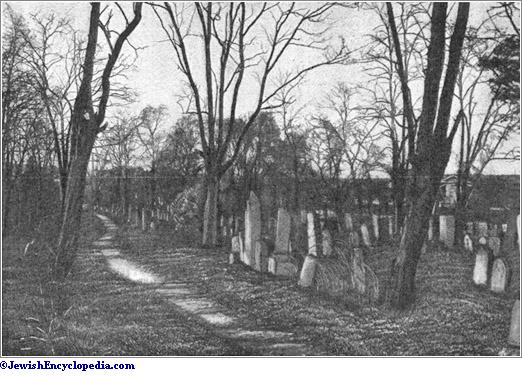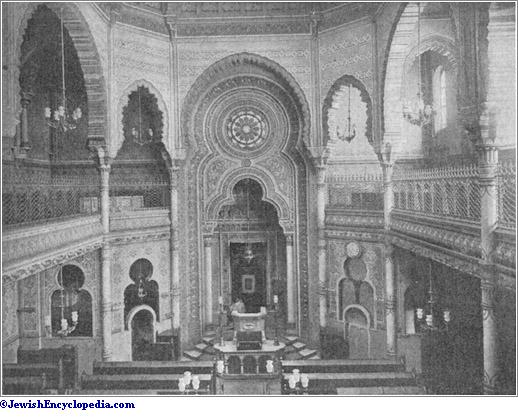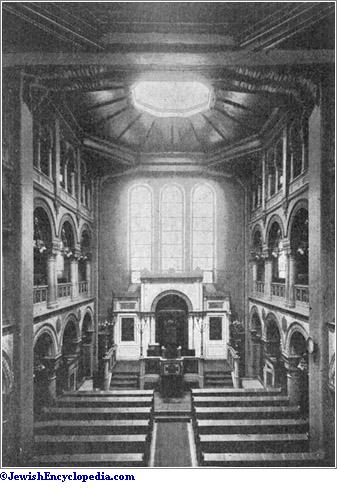Mayence
 From Jewish Encyclopedia (1906)
From Jewish Encyclopedia (1906) Mayence:
By: Gotthard Deutsch , Siegmund Salfeld
- Massacres During Crusades.
- In the Archbishopric.
- Community Reorganized.
- Social Condition.
- Scholars and Rabbis.
- Recent Developments.
- The Rabbinate.
German city in the grand duchy of Hesse-Darmstadt; on the left bank of the Rhine; the seat of an archbishop, who was formerly one of the prince-electors of the Holy Roman Empire. It has a population of 84,251, of whom 3,200 are Jews. Although there are no historical documents relating to Jewish settlements while Mayence was under Roman rule, it may be assumed that Jews followed the Roman legions to the Rhine in the first centuries of the common era. Legend reports that Charlemagne called Kalonymus of Lucca as rabbi to thecongregation of Mayence, but documentary evidence of the existence of Jews in Mayence does not antedate the first half of the tenth century, when Archbishop Frederick (937-954) made an unsuccessful attempt to restrict Jewish commercial activity. In 1012 the peace of the Jews of Mayence was disturbed by a religious persecution instigated by Henry II., and which led to apostasy or banishment. After a few months, however, the exiles returned to the city, and most of the converts to Judaism. In the following period of peace the intellectual life of the Jews of Mayence flourished as never before, under various members of the Kalonymus family and under other Talmudic authorities, including in particular Gershom Ben Judah .
Massacres During Crusades.
In 1084 the Jews were accused of having caused a conflagration which destroyed a large part of the city, and many emigrated in consequence. These refugees were received by Bishop Rüdiger Huozman of Speyer, who desired to build up his city. (The charter dated 1090 and supposed to have been issued by this bishop is a forgery of later times, based on a document of Henry IV.) Under the leadership of Emicho of Leinigen the Crusaders attacked the Jews of Mayence May 27, 1096, massacring more than eleven hundred in the city and fifty-three who had fled to the neighboring Rüdesheim, in spite of their brave resistance and of the protection of Archbishop Ruthard. Included by Henry IV. in the "king's peace" of 1103, the community slowly recovered, until in 1147 the Second Crusade claimed more victims, in consequence of the agitations of the monk Radulph. Persecutions which threatened the Jews in 1187 and 1188 were averted by the bishop and the emperor Frederick Barbarossa. Toward the end of the thirteenth century the accusation of ritual murder was raised at Mayence. In June, 1281, R. Meïr b. Abraham ha-Kohen was slain and the synagogue desecrated and burned; on April 19, 1283, ten Jews were slain by the populace. The persecutions spread throughout the vicinity, and in 1285 the Jews of Mayence, Worms, Speyer, Frankfort-on-the-Main, and the Wetterau decided to abandon their property and to emigrate to Palestine under the leadership of R. Meïr of Rothenburg . The real estate left at Mayence—in the most beautiful part of the city, the so-called "Judenerben"—was seized by the city in 1286, but was confiscated to the state by Archbishop Adolf II. in 1462. The Jews of Mayence escaped the massacres of 1298 under Rindfleisch and 1338-39 under Armleder . In August, 1349, at the time of the Black Death, nearly the whole community perished, and the ghetto was set on fire. The community gradually revived, however, and lived in peace for nearly ninety years, until the Jews were expelled from the city July 25, 1438, in consequence of municipal quarrels; their cemetery and synagogue were confiscated, and the tombstones were used for building purposes. When the old city government was overthrown in 1414 the Jews were permitted to return by Archbishop Diether, who claimed them as his property. Expelledagain in 1462 by Archbishop Adolf, though soon readmitted, they were obliged to leave the city definitely in 1473, their synagogue being transformed into a chapel. On March 6, 1492, a Jew named Isaac was permitted to occupy and manage the "miḳweh" (ritual bath), which had been owned by the state for twenty years, and to bury in the "Judensand," mentioned as a cemetery as early as 1286, the Jewish dead brought into the city.
In the Archbishopric.The sufferings of the Jews of the metropolis were shared by those in various localities in the archbishopric, where Jews had settled since the Carlovingian time. This is clear from the following partial summary of places which suffered: Aschaffenburg, persecutions in 1147, 1337, 1349; Amorbach, 1349; Bensheim, 1349; Bingen (mentioned in 1160-73), 1349; Dieburg, 1349; Eltville, 1349; Erfurt, 1221, 1266, 1349; Fritzlar, 1349; Heppenheim, 1349; Heiligenstadt - im - Eichsfeld, 1349; Klingenburg, 1298; Königheim, 1298; Königshofen, 1298, 1349; Krautheim, 1298; Külsheim, 1337; Lahnstein, 1287, 1349; Lorch, 1276, 1337; Miltenberg, 1349; Neudenau, 1298; Ostheim, 1298; Seligenstadt, 1349; Tauberbishofsheim, 1235, 1298, 1337, 1349.
Community Reorganized.
In the beginning of the sixteenth century only one Jewish family was living at Mayence. In the diocese of Mayence, outside the city, Jews were living under the protection of Archbishop Uriel of Gemmingen, who, on June 2, 1513, appointed the "Jews' doctor" Beyfus to the position of "rabbi, 'Hochmeister,' corrector, and chief judge" of all the Jews in the diocese, assigning him the village of Weisenau near Mayence as his residence. A movement inaugurated by Archbishop Albrecht of Brandenburg in 1516 to expel all Jews from western Germany failed through the intervention of the emperor Maximilian. The few who found a domicil at Mayence in the sixteenth century were obliged to leave in 1579, together with those of the district of the Rhine. A new community was founded in 1583, which received accessions from Frankfort-on-the-Main in 1614, after the Fettmilch insurrection in that city, and from Worms in 1615, on the expulsion of the Jews there. Elijah Loans, who brought with him refugees from Hanau, reorganized the community of Mayence. A rabbi was officially appointed in 1630, and a new Synagogue was built nine years later. While the French held Mayence (1644-48) the community was subjected to heavy burdens, and scarcely were these trials passed when the elector Johann Philipp decreed, Dec. 8, 1662, that only twenty Jews should be protected and be permitted in the city, this number being reduced to ten in 1671. These were compelled to move into anew Jews' street and to submit to the most humiliating restrictions, while the Jews who were permitted to settle in neighboring localities were equally hampered. Although subsequent electors permitted Jews to go to Mayence, only 101 "protected" Jews were allowed there during the electorate.
The government, inspired by the tolerant legislation of Joseph II. of Austria, endeavored, even before the outbreak of the French Revolution, to ameliorate the condition of the Jews in the archbishopric. The first steps taken were the inquiry of 1782 and the rescript of July 29, 1783, while the general rescript of Feb. 9, 1784, was intended to bring about a complete change. After determining the salary of the rabbi and of the Jewish provincial board at Aschaffenburg, declaring the German language to be obligatory in book-keeping, regulating the laws of dowry and guardianship, forbidding hasty burial, decreeing that every teacher must pass the state examination, and enacting the establishment of two or three Jewish schools in the electorate, the rescript continues: "In order to neglect nothing which may contribute to the education and the future welfare of the Jews, we permit, although we do not command, the Jewish youth of both sexes and all ages, like the Christian, to attend the Christian village and city ("Real und Normal") schools, especially in the electoral capital Mayence, and schools of all kinds." Further legislation beneficial to the Jews was checked by the outbreak of the French Revolution. From the capture of the fortress of Mayence on Oct. 21, 1792, by the French to its restoration to Germany by the terms of the Peace of Paris Nov. 3, 1814, the Jews of the city were free French citizens. The gates of the ghetto were removed on Sept. 12, 1798, by a decree of the municipal council. Members of the Mayence community were among the delegates sent to Paris in 1806 from the department of Mont Tonnerre, of which Mayence was the capital; the community sent delegates also to the Great Sanhedrin, held in the same city.
After civic liberty had been won, work on behalf of education and progress was undertaken. The regulation, introduced by Napoleon's decree of May 17, 1808, and providing that Jews must hold certificates of good character before being permitted to engage in trade, remained in force until 1847. After Mayence was incorporated with the grand duchy of Hesse June 16, 1816, full citizenship was guaranteed to the Jews therein by the law of Dec. 17, 1820, though this provision was not entirely kept. By the decree of Nov. 2, 1841, the community of Mayence, with the other communities of Hesse, was reorganized; on the establishment of the German empire they were granted full civic equality.
Social Condition.
In spite of occasional outbreaks of mob violence the lives and the property of the Jews of Mayence were generally protected by law, and they held property under the same conditions as the Christians, with whom they lived peaceably. In the twelfth century they were made
In days of peace as well as in days of oppression and persecution the Jews of Mayence preserved and cultivated their literature. An academy founded by the family of Kalonymus in the tenth century—which reached its zenith under R. Gershom and his contemporaries and pupils Judah ha-Kohen, Eliezer b. Isaac, Jacob b. Yaḳar, Isaac ha-Levi, Isaac b. Judah, and others—competed with that of Worms, sending its pupils into all countries. The religious, marital, social, and industrial life of the Jews of the Middle Ages was regulated by the decrees of the rabbinical synods held at Mayence in 1150, 1223, 1245, 1307, and 1381, as it had formerly been governed by the decrees of the French synod held at Troyes in the beginning of the twelfth century, and still earlier by the "regulations" ("taḳḳanot") of R. Gershom. The affairs of the community were directed, probably down to the end of the fourteenth or the beginning of the fifteenth century, by the "Judenrat," under the presidency of a Bishop of the Jews (called in the documents also "Jews' pope") appointed by the archbishop. Religious affairs were conducted by the rabbi and his college. After the reorganization the Jews of Mayence lived under simple regulations, rarely being without spiritual leaders, a well-attended yeshibah, and all the usual institutions of a well-ordered community.
A list of the most prominent scholars and rabbis down to the middle of the fifteenth century, and a complete list beginning with 1583, are given below:
Scholars and Rabbis.- Members of the Kalonymus family;
- Gershom b. Judah, Me'or ha-Golah (c. 960-1028, or 1040);
- Simon b. Isaac ha-Gadol (beginning of the 11th century);
- Eliezer b. Isaac ha-Gadol (c. 1040);
- Judah ha-Kohen (author of a legal code; c. 1040);
- David b. Samuel ha-Levi (c. 1050);
- Abraham b. Judah ha-Kohen (c. 1060);
- Isaac b. Judah (c. 1080);
- Jacob b. Yaḳar (c. 1080);
- Isaac ha-Kohen ([b. Abraham?]; c. 1080);
- Isaac b. Eleazar ha-Kohen (1093);
- martyrs of the First Crusade (1096): David, Judah ha-Levi, Menahem b. David, Samuel b. Judah the younger, Samuel b. Judah ha-Kohen;
- Abraham b. Isaac ha-Kohen (c. 1100);
- Nathan b. Machir (c. 1100);
- Eliakim b. Joseph (c. 1130);
- Kalonymus b. Judah (c. 1140), Eliezer b. Nathan (c. 1150);
- Meshullam b. Kalonymus (c. 1150);
- Judah b. Kalonymus b. Moses (c. 1175);
- Moses b. Mordechai (c. 1175);
- Moses b. Solomon ha-Kohen (c. 1175);
- Solomon b. Moses ha-Kohen (c. 1200);
- Samuel b. Solomon (13th cent.);
- Baruch b. Samuel (c. 1220): Judah b. Moses ha-Kohen (c. 1250);
- Meïr b. Baruch of Rothenburg (1230-93);
- Yaḳar b. Samuel ha-Levi (later in Cologne, 1270);
- Abraham b. Meïr ha-Kohen (murdered in 1281);
- Jacob b. Isaac (d. 1318);
- Isaac b. David (d. 1329);
- Samuel b. Yaḳar (called "Bonfant"; ḥazzan; d. Sept. 23, 1345);
- Joseph b. Isaac of Thann (slain 1349);
- Eliezer b. Samuel ha-Kohen (d. 1357);
- Jacob of Nordhausen (c. 1365);
- Jehiel b. Moses ha-Levi (d. Nov. 14, 1380);
- Moses b. Jekuthiel ha-Levi (1381);
- Todros (c. 1400);
- Zalman Runkel (c. 1420);
- Jacob b. Moses ha-Levi (Maharil; c. 1355-1427);
- Moses Minz (left Mayence 1455);
- Judah Minz (brother of Moses; left Mayence; d. Padua 1508);
- Joshua Moses b. Solomon Luria (d. 1591);
- Reuben b. Solomon (d. 1598);
- Joseph (d. 1603);
- David b. Isaac (d. 1613);
- Eli Nathan b. Joseph Moses (d. 1631);
- Judah Löwe of Frankfort (1630-33);
- Löb Rofe (1634-44);
- Nathan, son of Isaac Jacob Bonn of Frankfort (1644-50);
- Saul Judah b. Moses Naphtali (1650-56);
- Simon Goldisch (1656-62);
- Jacob Simon (1662-68);
- Jacob of Ostrog (1668-74);
- Samuel Sanwil of Lublin (1675-78);
- David b. Aryeh Löb of Lida (1679-83);
- Wolf Traub (1683-87);
- Judah Löb b. Simon (1687-1714);
- Isaac Seckel b. Immanuel (1715-21);
- Bernhard Gabriel Eskeles (1721-23);
- Isaac Seckel Ethausen (1723-29);
- Bernhard Wiener (1730-32);
- Moses Brandeis (Moses Ḥarif; 1733-67);
- David (Tewele) Scheuer (1768-82);
- Noah Ḥayyim Ẓebi Berliner (1783-1800);
- Herz Scheuer (1800-10, and 1814-22);
- Samuel Wolf Levi (1810-14);
- Löb Ellinger (Schnadig; 1823-47);
- Joseph Aub (1853-66;
- later in Berlin; d. 1880);
- Benedict Cahn (until 1879; d. 1886);
- Marcus Lehmann (rabbi of the Religionsgesellschaft; 1854-90);
- Julius Fürst (until 1881);
- Siegmund Salfeld (since 1880): Jonas Bondi (rabbi of the Religionsgesellschaft since 1890).
After the French period the conditions for a time were as they had been under the electorate; but in 1830 the Hessian government undertook to regulate the affairs of the Jewish community. The internal development of the community proceeded slowly. In 1836 instruction in the Jewish religion was made obligatory in the high schools. In 1853 R. Joseph Aub was called to the rabbinate, with R. Benedict Cahn as assistant rabbi and teacher of religion; and in the same year the new synagogue was dedicated. The reforms introduced in this synagogue caused a number of the Orthodox members of the community to form a separate congregation—the Religionsgesellschaft, which built its own synagogue and organized a school. It continued to participate in all the affairs of the community, and as few of the members of this separate congregation left it when the law of 1878 was promulgated, a large part of the communal taxes is remitted to it annually for its religious expenses. Mayence is the birthplace of Michael Creizenach, Isaac Bernays, Joseph Derenbourg, Ludwig Bamberger, and other notable men.
Following is a list of the synagogues and other communal institutions of Mayence: principal synagogue, dedicated in 1853 (see illustration); synagogue of the Religionsgesellschaft, dedicated in 1879 (see illustration); school, founded Nov. 11, 1880; elementary and religious school of the Religionsgesellschaft, founded in 1859; ritual bath (miḳweh), rebuilt in 1888; the old cemetery—first mentioned in 1286, closed in 1880 (see illustration); the new cemetery, opened in 1881 (see illustration); hospital and poorhouse, opened in 1904; various other charitable and religious societies, including a society for Jewish literature, a Zionist society, and a Bene Berit lodge. In April, 1904, while certain excavations were being made in the city, a remarkable building was discovered, which has been named the "House of Kalonymus."
The Rabbinate.The grand-ducal rabbinate of Mayence, in chargeof Dr. Siegmund Salfeld, includes the communities of the following places: Bodenheim, Bretzenheim-Finthen, Dalheim, Dolgesheim, Ebersheim-Harxheim, Essenheim, Guntersblum, Hahnheim, Kastel, Mayence, Mommenheim, Niederolm, Oherolm, and Oppenheim-Nierstein (where Jews have been living since the middle of the thirteenth century; see Kayserling, "Die Juden in Oppenheim," in "Monatsschrift," ix. 295 et seq. ), Sörgenloch, and Weisenau.
- Documents in the Allgemeines Reichsarchiv at Munich, the Kreisarchiv at Würzburg, the Hof- und Staatsarchiv at Darmstadt, the archives of the Jewish community at Mayence, and in the Mayence city library;
- Joannis, Scriptores Rerum Moguntiacarum, i. 526;
- Jaffé, Monumenta Moguntina;
- Gudenus, Codex Diplomaticus;
- Will, Regesta Archiepiscop. Mogunt.;
- Schunck, Codex Diplomaticus;
- Aronius, Regesten;
- Böhmer, Fontes, iv. 543;
- Neubauer-Stern-Baer, Hebräische, Berichte über die Judenverfolgung Während der Kreuzzüge, in Quellen zur Gesch. der Juden in Deutschland, ii. 2et seq.;
- Salfeld, Martyrologium;
- Schaab, Diplomatische Gesch. der Juden in Mainz, Mayence, 1855;
- Hegel, Städtechroniken, Mainz II. Verfassungsgesch. pp. 165 et seq.;
- Bodmann, Rheingauische Alterthümer, ii. 712 et seq.;
- Wiener, Regesten;
- Bresslau, Zur Gesch. der Juden in Deutschland, in Steinschneider, Hebr. Bibl. x. 169 et seq.;
- Carmoly, Die Juden zu Mainz im Mittelalter, in Israelit, 1865, 1866;
- Stern, Quellenkunde zur Gesch. der Deutschen Juden, Nos. 857-868;
- Carlebach, Die Rechtlichen und Socialen Verhältnisse der Jüdischen Gemeinden Speyer, Worms und Mainz. Leipsic, 1901;
- Stern, König Ruprecht von der Pfalz in Seinen Beziehungen zu den Juden, Kiel, 1898;
- Salfeld, Bilder aus der Vergangenheit der Jüdischen Gemeinde Mainz, Mayence, 1903;
- Leopold Rothschild, Die Judengemeiuden in Mainz, Speyer und Worms von 1349-1438, Berlin, 1904;
- Bresslau, in Zeit. für die, Gesch. der Juden in Deutschland, ii. 82 et seq.;
- Grätz, Gesch. vi. 96, 101; vii. 186, 374; viii. 252 et seq., 273 et seq.;
- Stern, Der Hochverratsprozess Gegen die Deutschen Juden im Anfange des 17. Jahrhunderts, in Königsberger Monatsblätter, pp. 33 et seq., Berlin, 1890.
- On the rabbis see Zunz; Güdemann;
- Kohn, Mordechai ben Hillel, Breslau, 1878;
- Michael, Or ha-Ḥayyim;
- Carmoly, Zur Gesch. der Rabbiner in Mainz, in Klein's Schulbibliothek, ii. 156 et seq.;
- Memorbuch of the Community of Mayence, 1583-1847.
Categories: [Jewish encyclopedia 1906]
↧ Download as ZWI file | Last modified: 09/04/2022 16:26:43 | 66 views
☰ Source: https://www.jewishencyclopedia.com/articles/10305-mainz.html | License: Public domain
 ZWI signed:
ZWI signed: KSF
KSF